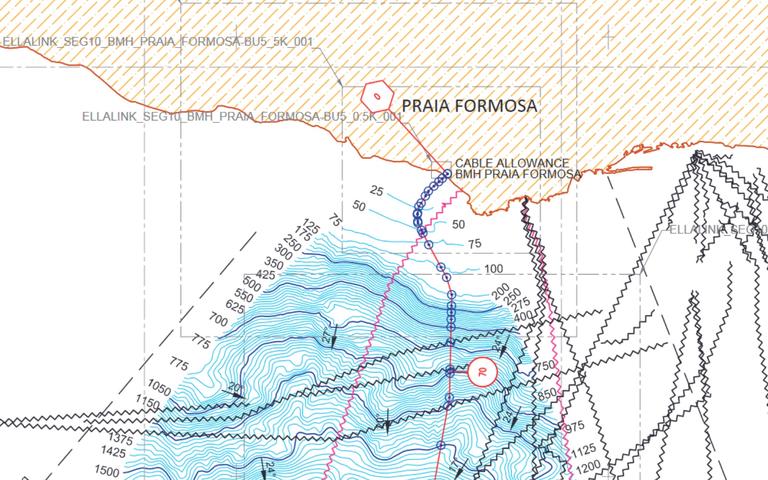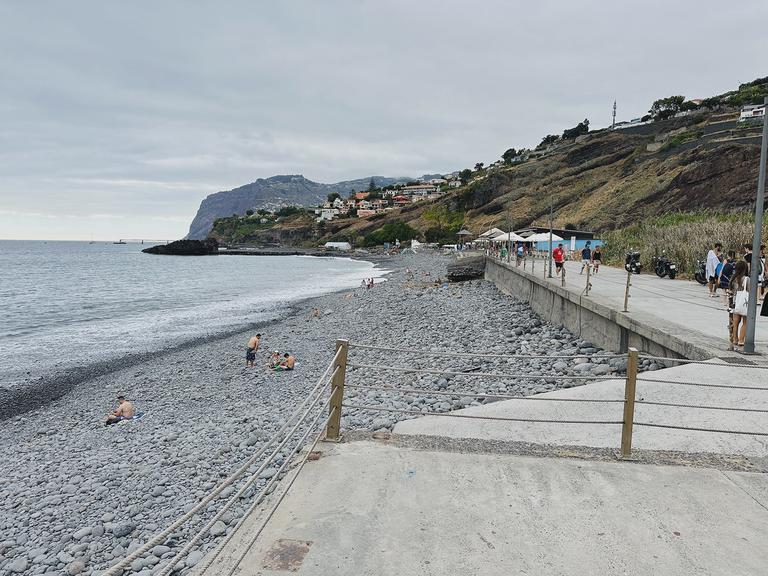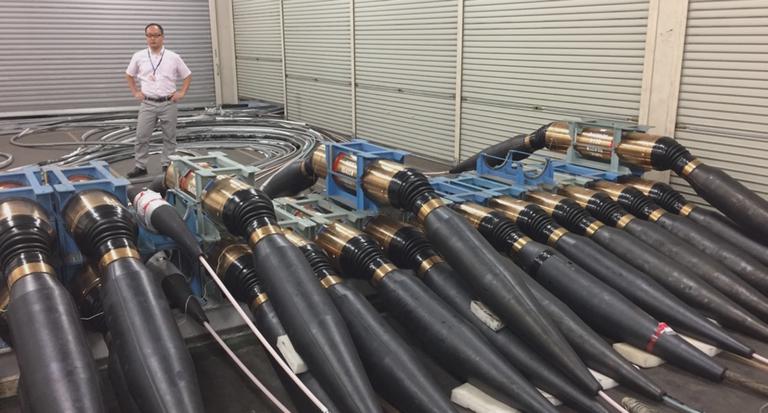Madeira Submarine Cables
I recently visited the Island of Madeira on vacation and was impressed with their internet speed. For an island in a remote part of the Atlantic it was not something I expected. After looking further into the island’s internet connectivity I peaked into a new view of the region’s politics and technological history.
Madeira is an autonomous region of Portugal and boasts a rich history shaped by its strategic location in the Atlantic Ocean. Discovered by Portuguese explorers João Gonçalves Zarco and Tristão Vaz Teixeira in 1419, Madeira quickly became an important stopover on trade routes between Europe, Africa, and the Americas. The island’s fertile volcanic soil allowed it to flourish as an agricultural hub, with sugarcane production dominating its early economy. Over time, Madeira developed a reputation for producing world-renowned fortified wine, a staple of its economy that continues to be a significant export today.
In modern times, Madeira’s economy is supported by several key industries, with tourism playing a central role. The island’s stunning landscapes, mild climate, and cultural heritage attract visitors year-round. Agriculture remains important. particularly the cultivation of bananas, grapes, and other fruits, alongside the production of Madeira wine. Additionally, Madeira has developed a strong service sector, including financial services and real estate, benefiting from its status as an autonomous region with favorable tax and cryptocurrency regulations.
Madeira’s early internet connectivity was established in the late 20th century, marking a significant milestone in its integration with the global digital community. The island’s remote location presented challenges, but these were overcome with the installation of submarine fiber optic cables, which connected Madeira to mainland Europe. This early adoption of internet infrastructure has allowed Madeira to participate in the global economy more effectively, facilitating business, education, and tourism. Today, the island continues to invest in advanced telecommunications to maintain its competitive edge as a modern and connected autonomous region within Portugal.
These technology investments are becoming more politically oriented as Portugal and many other member states of the European Union have started pushing to expand and solidify the region’s digital sovereignty.1 Such a term is wide but includes things such as classifying submarine cables as critical infrastructure, fortifying regional-local technology manufacturing, and diversifying connectivity to rival or replace foreign technology giants like Google or Amazon.2
Some of these pursuits might be counterproductive as Portugal attempts to attract further submarine cable connections and investments to shore.2 With already 10 to 15% of the world’s data traveling through cables on Portugal’s shores it adds significant security and operational risk. Consolidation to a single shore or location would increase vulnerability to intentional or unintentional issues with cable connectivity. The Portuguese Navy has identified several Russian ships that have been seen surveying submarine cables along the Portuguese coast.3 While looking at submarine cables are harmless it occurs in the context of Dmitry Medvedev’s threats about “destroying enemies’ communication cables.”3
On a broader perspective, a report by European Parliament noted a severe uptick in 2017 for Russian interest in locating NATO member state undersea cable infrastructure.4 A member of the Irish military described that Russia does not necessarily want to cut these submarine cables but wants NATO members to be aware that they can anytime.4 As the technology magazine Wired describes it, it is the most vulnerable place on the internet.5
Madeira plays an interesting role in this geopolitical grandstanding. It isn’t a major telecommunication’s hub like the coast of Portugal so it is most likely seen as less important by major players. However, this might change in the future as further cables are laid from Europe to South America and Africa.
Local Providers
Telecommunications infrastructure on the island is overseen by Telecomunicações da Madeira (EMACOM), which is a subsidiary of the municipal electrical company, Electricidade da Madeira. Infrastructure is built and maintained to be carrier neutral. The most prevalent consumer providers are MEO AS3243 and NOS Madeira AS15457/AS2860.
Of the two companies, MEO has a larger presence in the market. It is a subsidiary of Altice and launched in Madeira in 1995. MEO is currently originating 7,204 /24’s of IPv4 space over 15 prefixes. It has a single upstream connected through Altice Portugal AS8657.
NOS Madeira is a bit more modest with 272 /24’s of IPv4 address origination over 8 prefixes. As a subsidiary of NOS in Portugal it also has a single upstream connection over NOS AS2860.
EllaLink
Up until June of 2021 the only direct link between Europe and South America was the Atlantis 2 submarine cable, which had capacity of 40 Gbps6 that limited it usage to telephony connectivity. All internet traffic between the regions had to transit through the United States. While not optimal, it didn’t take on new urgency until the Edward Snowden leaks in the summer of 2013 that revealed the vast surveillance of the United States National Security Agency. In February of 2014 Brazilian President Dilma Rousseff stated one of the primary goals of EllaLink was to “guarantee the neutrality”7 of the internet.
The EllaLink project began in 2015 but installation of the submarine cable didn’t begin until 2020. The supplier was Alcatel Submarine Networks. Total cost for the full length of the EllaLink submarine cable ranges from 150 million euros to 185.8 Madeira contributed 13.6 million euros9 for the cable between the island to Sines, Portugal. Another 1.5 million euros was contributed by Madeira to improve the cable landing station near the Praia Formosa beach and the Amparo Terrestrial Station.

The above geographic survey was performed by Alcatel Submarine Networks, Elettra, and GeoTeam. It shows the landing of EllaLink at Praia Formosa and is identified as a red line with blue circles around it. The survey map is available through the Madeira government website. There are additional documents available that outline the technique and tools used to bury the cable at the beach and how it is bolted down to the sea floor in shallow water.
EllaLink was completed in June of 2021 and ended up at a length of 6,200 km if including the branch off to Morocco. The cable itself is 4 pairs of fiber. With DWDM that gives 25 Tbps per pair for a total capacity of 100 Tbps.10 Latency from Portugal to Brazil should have a round-trip time (RTT) of less than 60ms. Farther destinations such as between Marseille and São Paulo should be less than 135ms.

One advanced feature of the EllaLink cable is that between the 75km segment from Madeira to the main EllaLink junction box is an extra GeoLab fiber pair. A GeoLab fiber cable is designed to monitor and gather data about the Earth’s geophysical processes, such as seismic activity and oceanographic conditions. The extra fiber pair for GeoLab data is a separate addition to the main EllaLink fiber pairs.
Measurements across this extra GeoLab fiber pair is performed by a Febus A1-R module that can identify acoustic changes in the fiber. This distributed acoustic sensing (DAS) technology is limited to a distance of about 100 km and can only be installed at either end of the cable.11 In this case, just on the Madeira side of things. For these reasons it isn’t as preferred as a system of Science, Monitoring, and Reliable Telecommunications (SMART) repeaters across the full length of a submarine cable. However, it still contributes a wealth of knowledge that was previously non-existent.
CAM Ring
The Continente Azores Madeira (CAM) Ring cable is a colloquial term in reference to the various connections between mainland Portugal and the autonomous regions of the Azores and Madeira. The information published by TeleGeography refers to misnamed or non-existent cables. However, statements by Autoridade Nacional de Comunicações (ANACOM) show that ATLANTIS-2 connects Madeira to Portugal12 and COLUMBUS-III connects Azores to Portugal with AZORES-MADEIRA between the islands.13
Regardless of the actual naming of these cables they have all reached the end of their usable life. Their 300 Gbps capacity is no longer sufficient for today’s bandwidth needs and there is an ever increasing risk for physical issues as usage is extended past the expected life span.
Anel CAM Ring
The successor to the aging CAM ring is the Anel CAM project, which needs and wishlist were outlined by ANACOM in late 2019.14 It was awarded for implementation to Alcatel Submarine Networks in March of 2024.15 Installation should finish by the end of 2026 and is estimated to cost 154.4 million euros.16 A sizable part of the cost will be paid for by a 5G auction. No specific cost information has been published for any contribution by Madeira itself. Yet with their recent improvements to their cable landing station infrastructure to accommodate the EllaLink cable I doubt any further on-island costs will be needed.
The planned route for Anel CAM will still circumvent in a ring around Madeira and Azores but has two landing locations in each region for added redundancy. It would include Terceira and São Miguel in Azores, Machico and Formosa in Madeira, and Carcavelos and Sines in Portugal. This could prove helpful during maintenance windows or natural disasters to keep connectivity working for other parts of the ring. Total length of the cable would be approximately 3,812 km and consist of 6 fiber pairs. This would provide an available bandwidth of 150 Tbps.
While a hub and spoke topology might have been more cost effective there are two major reasons a ring is more advantageous. The primary reason is redundancy through alternative paths on a ring topology. If there is maintenance or an outage traffic can simply redirect and still reach mainland Portugal. There is not a specific need for a connection between the islands of Madeira and Azores. I doubt the intra-island traffic amount is anything substantial so the connection is entirely for redundant connectivity.
The second reason is to increase necessary coverage of Science, Monitoring, and Reliable Telecommunications (SMART) sensors. These sensors are being incorporated into new submarine cables and can help provide information for tsunami warning systems (TWS) and earthquake early warning systems. They are placed around every 50 km along the cable and don’t interfere with the main fiber strands or overall life expectancy of the cable. Within the full span of the Anel CAM Ring that would be approximately 50 repeaters.

Adding sensors to the area between Azores, Madeira, and Portugal is especially important given the neighboring confluence of tectonic plates. A short distance away the Nubia, Eurasia, and North American plate boundaries grind against each other and provide for the potential of destructive earthquakes and tsunamis. The boundary between the Nubia and Eurasia plates are especially volatile. Over the past 1024 years the three largest European earthquakes have originated from this location. 13 This includes the infamous 1755 8.7 magnitude earthquake that resulted in a tsunami that almost completely wiped out the city of Lisbon and killed an estimated 30,000 to 40,000 people.
Given the region’s historical and modern threat of earthquake impact it is imperative to deploy early warning sensors. Many have been deployed on land but far fewer have penetrated offshore locations. With the evolution of SMART sensors these can now expand on the coattails of submarine cables all across the world.
The benefits of having these SMART sensors could be life saving. In some modeling cases there was a 10 to 30 minute warning advantage over coastal tide-gauges.13
Future Cables
Between EllaLink and Anel CAM the islands of Madeira will be in a good situation with 250 Tbps of bandwidth capacity for a good deal of time into the future. But for neighboring Azores there are some concerns about the end of life submarine cables for their 9 intra-island connections. These are not covered by the new Anel CAM cable project. The Azorean President took a moment to reiterate this need during the announcement of the Anel CAM project with ANACOM in São Miguel.17
For other future submarine cables planned within Madeira or the region it will be interesting to see how Portugal attempts to position itself as a landing station for the Atlantic. Whether or not this involves Madeira directly will depend on specific routes and needs of future submarine cables. EllaLink was only extended to Madeira after payment by the local government. It is not specifically needed and some future cables will entirely bypass Madeira to more infrastructure ready Carcavelos and Sines.
Laurens Cerulus, “Lisbon Eyes Undersea Cable Investment to Bolster EU Tech Infrastructure,” POLITICO, December 15, 2020, https://www.politico.eu/article/submarine-cables-europe-lisbon-eyes-undersea-investment-bolster-tech-infrastructure/. ↩︎
Laurens Cerulus, “Portugal Looks to Rule the Waves Again (Thanks to Undersea Data),” POLITICO, June 2, 2021, https://www.politico.eu/article/portugal-plugs-in-submarine-internet-cable/. ↩︎ ↩︎
Portugal Pulse, “The Threat Lurking in the Sea of Portugal: Sabotage of Submarine Cables Would Be a Catastrophe,” Portugal PULSE, June 19, 2023, https://www.portugalpulse.com/the-threat-lurking-in-the-sea-of-portugal-sabotage-of-submarine-cables-would-be-a-catastrophe/. ↩︎ ↩︎
Christian Bueger, Tobias Liebetrau, and Jonas Franken, “Security Threats to Undersea Communications Cables and Infrastructure - Consequences for the EU,” European Parliament, 2022. https://www.europarl.europa.eu/RegData/etudes/IDAN/2022/702557/EXPO_IDA(2022)702557_EN.pdf. ↩︎ ↩︎
Matt Burgess, “The Most Vulnerable Place on the Internet,” WIRED, November 2, 2022, https://www.wired.com/story/submarine-internet-cables-egypt/. ↩︎
Toms Dumpis, “New Optical Cable Will Link Morocco, Portugal,” Morocco World News, March 13, 2021, https://www.moroccoworldnews.com/2021/03/337236/new-optical-cable-will-link-morocco-portugal. ↩︎
Robin Emmott, “Brazil, Europe Plan Undersea Cable to Skirt U.S. Spying,” Reuters, February 24, 2014, https://www.reuters.com/article/2014/02/24/us-eu-brazil-idUSBREA1N0PL20140224/. ↩︎
Tobi Hughes, “Submarine Cable to Cross Madeira Costs 170 Million and Starts Transmitting Data in 2020,” Madeira Island News Blog (blog), October 7, 2019, https://www.madeiraislandnews.com/2019/10/submarine-cable-to-cross-madeira-costs-170-million-and-starts-transmitting-data-in-2020.html. ↩︎
Maurice Reed, “1,100 Km of Cable Connects Madeira to Mainland,” Madeira Island News Blog (blog), January 21, 2021, https://www.madeiraislanddirect.com/blog/2021/01/1100-km-of-cable-connects-madeira-to-mainland/. ↩︎
EllaLink - Submarine Cable With Lowest Latency, May 21, 2024, EllaLink, May 21, 2024, https://ella.link/. ↩︎
Dan Swinhoe, “Making Subsea Cables Smart, and Helping Save the Planet,” Data Centre Dynamics, June 7, 2022, https://www.datacenterdynamics.com/en/analysis/making-subsea-cables-smart-and-helping-save-the-planet/. ↩︎
Paulo Simões, Rui Jorge Cabral, “With the New Submarine Cables We Will Have the Largest Real-time Laboratory in the Atlantic,” Açoriano Oriental, March 21, 2023, https://www.acorianooriental.pt/noticia/with-the-new-submarine-cables-we-will-have-the-largest-real-time-laboratory-in-the-atlantic-348910. ↩︎
Luis Matias, Yasser Omar, Fernando Carrilho, Vasco Sá, Rachid Omira, Carlos Corela, Rui A. P. Perdigão, and Afonso Loureiro, “The contribution of the CAM fibre optic submarine cable telecom ring to the early warning of tsunami and earthquakes,” European Geosciences Union General Assembly 2020, May 4, 2020, https://doi.org/10.5194/egusphere-egu2020-13988 ↩︎ ↩︎ ↩︎
José S. Barros, “Atlantic Submarine Cable Platform: A Smart, Green, and Blue Approach,"Autoridade Nacional de Comunicações, February 12, 2019, https://www.anacom.pt/streaming/Atlantic_CAM_Platform_SGBCAM_full_version.pdf?contentId=1468523&field=ATTACHED_FILE ↩︎
“Alcatel Submarine Networks Selected for the Groundbreaking Anel CAM Submarine Cable Project in Portugal,” Alcatel Submarine Networks, March 19, 2024, https://www.asn.com/press-release/anel-cam/. ↩︎
Winston Qiu, “IP And ASN Sign Contract for Construction of New CAM Ring,” Submarine Cable Networks, March 26, 2024, https://www.submarinenetworks.com/en/systems/intra-europe/new-cam-ring/ip-and-asn-sign-contract-for-construction-of-new-cam-ring. ↩︎
Sara Ribeiro, “Governo Dos Açores Pede Urgência Na Substituição Dos Cabos Interilhas,” Jornal de Negócios, July 26, 2024. https://www.jornaldenegocios.pt/empresas/detalhe/governo-dos-acores-pede-urgencia-na-substituicao-dos-cabos-interilhas-que-estao-em-fim-de-ciclo-de-vida. ↩︎